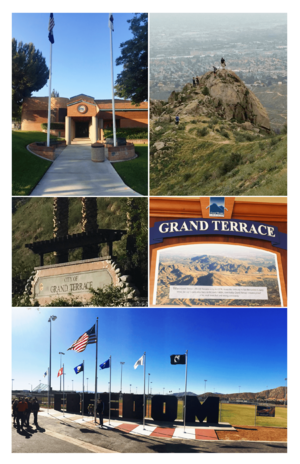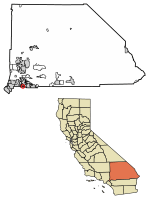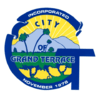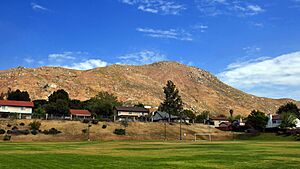Grand Terrace, California facts for kids
Quick facts for kids
Grand Terrace, California
|
||
|---|---|---|

City of Grand Terrace images from top, left to right - Grand Terrace City Hall, Blue Mountain Trail, Northeast City Entrance, Historical Plaque, Veterans Wall of Freedom
|
||
|
||

Location of Grand Terrace in San Bernardino County, California.
|
||
| Country | ||
| State | ||
| County | ||
| Incorporated | November 30, 1978 | |
| Government | ||
| • Type | Council-manager | |
| Area | ||
| • Total | 3.50 sq mi (9.08 km2) | |
| • Land | 3.50 sq mi (9.08 km2) | |
| • Water | 0.00 sq mi (0.00 km2) 0% | |
| Elevation | 1,063 ft (324 m) | |
| Population
(2020)
|
||
| • Total | 13,150 | |
| • Density | 3,590.30/sq mi (1,386.33/km2) | |
| Time zone | UTC-8 (PST) | |
| • Summer (DST) | UTC-7 (PDT) | |
| ZIP code |
92313
|
|
| Area code(s) | 909, 840, 951 | |
| FIPS code | 06-30658 | |
| GNIS feature ID | 1660692 | |
Grand Terrace is a city in San Bernardino County, California, United States. In 2010, about 12,040 people lived there. This was more than the 11,626 people counted in 2000.
Grand Terrace is located between the towns of Highgrove and Colton. It sits near the I-215 highway. The city is surrounded by two mountain ridges. To the east is Blue Mountain. To the west are the La Loma Hills.
Contents
History of Grand Terrace
The story of Grand Terrace began a long time ago. Its first roots were in Mexican land grants between 1830 and 1840. Later, in the 1850s, Mormon settlers arrived in the San Bernardino Valley.
In 1876, there were only nine buildings in the area. It was first called "the Terrace." Around 1898, the word "Grand" was added. This was because of the beautiful views all around the city.
In 1905, Seventh-day Adventists moved to the area. Their medical university is now in nearby Loma Linda. Grand Terrace, once known as "South Colton," grew a lot. This happened during the growth of Southern California's suburbs in the late 1900s.
How Grand Terrace Grew
Grand Terrace became a real community with the building of the Gage Canal. This canal was 22.5 miles long. It cost 2 million dollars to build. The canal brought water from the Santa Ana River. With plenty of water, Grand Terrace quickly became a farming area. It was known for its excellent citrus fruits.
However, a big freeze in 1913 destroyed many fruit groves. Farmers then planted hardier trees like walnuts. They also grew peaches for quick money.
Community Life and Cityhood
In the early 1900s, social life centered around the Farm Bureau and the Women's Club. Later, in the 1930s, the PTA became important. There were no local churches, so people traveled to nearby towns for worship.
In 1962, the Grand Terrace Chamber of Commerce was formed. This group wanted to keep the area's unique identity. They strongly supported making Grand Terrace its own city.
This group did much of the work to create a local government. In 1976, a Municipal Advisory Council (MAC) was formed. After almost two years, residents voted on becoming a city. A large 82% voted yes.
On November 30, 1978, Grand Terrace officially became a city. It was the 16th city in San Bernardino County.
In 2007, Money magazine named Grand Terrace one of the "Top 100 Cities to Live In."
Geography
Grand Terrace is about 3.6 square miles (9.3 square kilometers) in size. The city's average height above sea level is about 1,065 feet (324 meters).
The city's motto, found on its flag, is "The Blue Mountain City." Its official slogan is "A city set upon a mountain cannot be hidden." These names refer to the Blue Lupine flower. This flower used to grow on Blue Mountain every spring.
The United States Census Bureau states that the city is entirely land. It has no water areas within its borders.
Population and People
| Historical population | |||
|---|---|---|---|
| Census | Pop. | %± | |
| 1970 | 5,901 | — | |
| 1980 | 8,498 | 44.0% | |
| 1990 | 10,946 | 28.8% | |
| 2000 | 11,626 | 6.2% | |
| 2010 | 12,040 | 3.6% | |
| 2019 (est.) | 12,584 | 4.5% | |
| U.S. Decennial Census | |||
In 2010, Grand Terrace had a population of 12,040 people. This means there were about 3,438 people living in each square mile.
Most residents were White (65.7%). About 5.6% were African American, and 6.5% were Asian. Native Americans made up 1.0% of the population. People of two or more races were 5.2%. About 39.1% of the population identified as Hispanic or Latino.
Most people (99.1%) lived in homes. Only a small number lived in group housing or institutions. There were 4,403 households in the city. About 35.2% of these homes had children under 18.
In 2010, the typical household income in Grand Terrace was $64,073. About 6.5% of the people lived below the poverty line.
Education
The Colton Joint Unified School District serves students in Grand Terrace. This district includes several schools. These are Grand Terrace Elementary School, Terrace View Elementary School, and Terrace Hills Middle School. Students also attend Grand Terrace High School. These schools are part of the Ray Abril Jr. Educational Complex.
The Roman Catholic Diocese of San Bernardino also has a facility in Grand Terrace. It is called the Blessed Junipero Serra House of Formation.
See also
 In Spanish: Grand Terrace para niños
In Spanish: Grand Terrace para niños




